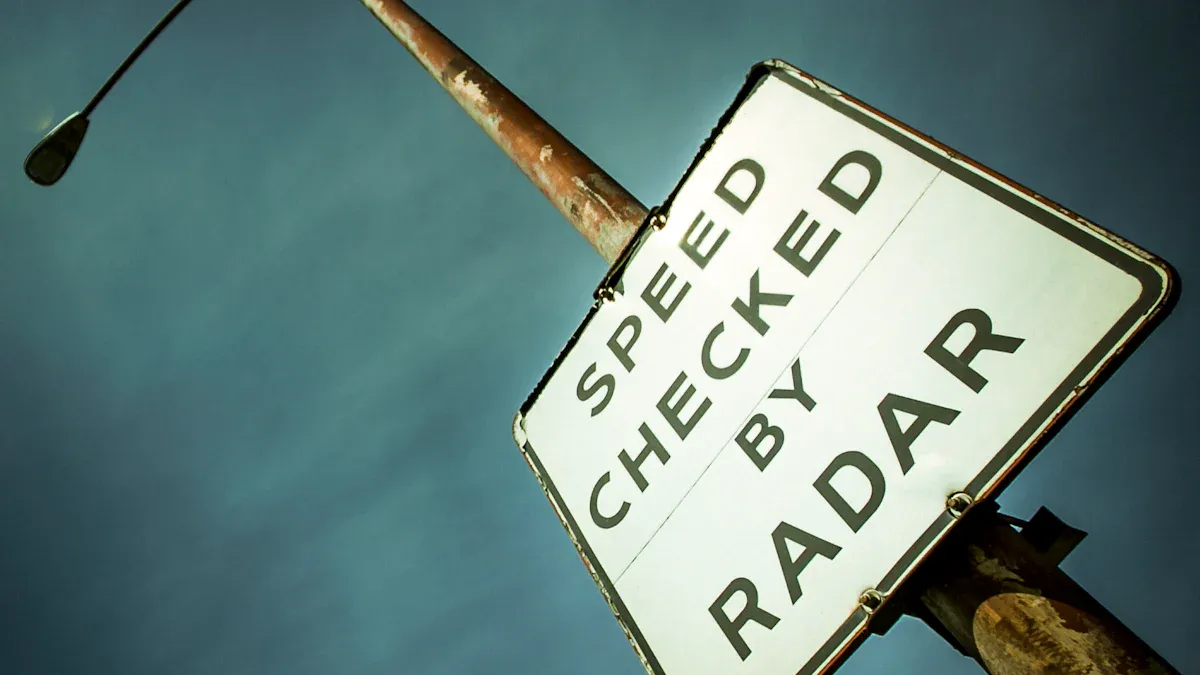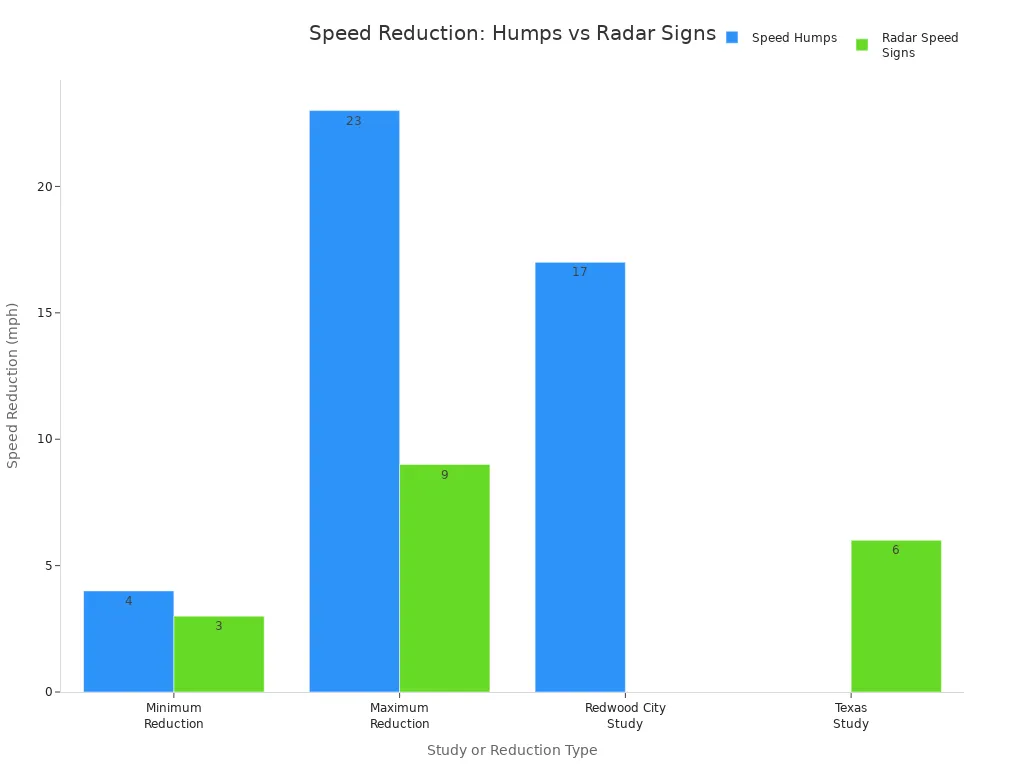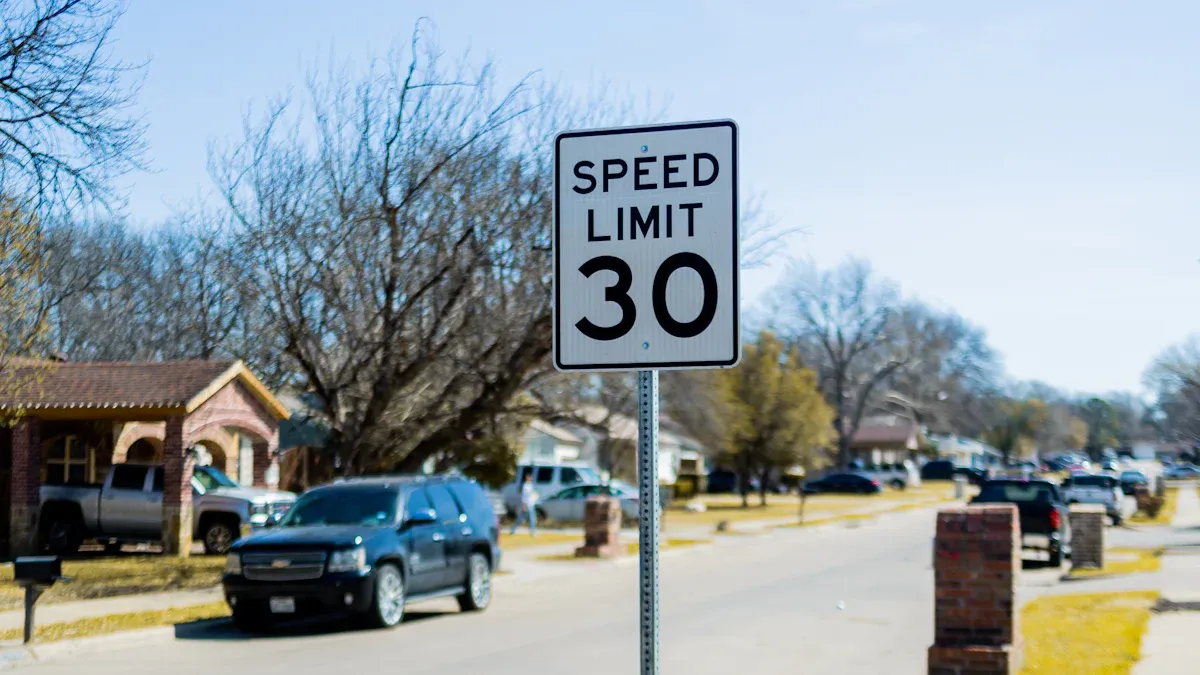- All
- Product Name
- Product Keyword
- Product Model
- Product Summary
- Product Description
- Multi Field Search
Views: 0 Author: Site Editor Publish Time: 2025-08-13 Origin: Site









Police Presence Level | Measures of Effectiveness Improved |
|---|---|
Radar speed display with police decal & light | Statistically significant improvements |
Passive police vehicle with radar speed display | Statistically significant improvements |
Passive police vehicle without radar display | Statistically significant improvements |
Active police speed enforcement | Statistically significant improvements |
You see fewer cars speeding, more people watching their speed, and safer neighborhoods when radar speed signs and speed limit signs are used.
Radar speed signs show your speed right away. This helps you slow down and drive more safely. - These signs help police by giving them data. Police use this data to find speeders and make roads safer. - Radar speed signs can lower speeds by 3 to 9 mph. They also help stop accidents, especially near schools and work zones. - If you install and check radar speed signs often, they stay correct and work well. - Using radar speed signs makes roads safer. It helps drivers have better habits and builds trust in the community.

lower speeds by 4 to 5 mph
build a safer road culture
Tip:
Lake Forest Park uses radar speed signs with cameras
lowers injury crashes by 20-25%
Here are some real examples of radar speed sign use
Location | Speed Reduction Observed | Safety/Enforcement Outcome |
|---|---|---|
Kirkland, Washington | Average speeds dropped by 1.19 to 2.21 mph | 5% fewer accidents for each mph reduction |
Tigard, Oregon | 66% drop in average speeds near a school | Better safety for people walking |
Chandler, Arizona | Not listed, but radar signs installed | 79% fewer traffic deaths |
Suburban community | 30% drop in average speeds | Fewer speeding tickets and safer roads |
Finland | 10% speed drop after radar signs | Better traffic control and enforcement |
Radar speed signs also help people know about speed rules. When you see messages like “Slow Down,” you know your speed is checked. This makes you think before speeding. People in the community like these signs. They see less speeding and feel safer. Police say people ask for more signs in their area.
Radar speed signs collect traffic dataspeed controlway to talk to drivers
Doppler effectwithin one kilometer per hoursign’s angle
main parts
Radar sensors that check your speed
LED displays that show your speed, even in sunlight
Controllers and software that run the sign and handle data
Solar panels and batteries that give the sign power, even at night
solar powered radar speed sign
Radar speed signs give you feedback right away. When you get close, the sign shows your speed on a digital screen. If you are going too fast, the sign flashes or uses bright lights to warn you. This makes you notice your speed and slow down. Some signs have alarms that go off if you drive too fast. You might see messages like "Slow Down" or "Too Fast" to help you change your speed.
main features
Feature | Description |
|---|---|
Radar Detection | Checks your speed right away using Doppler radar. |
Digital Display | Shows your speed fast so you can see it. |
Flashing/Strobe Lights | Warns you with lights if you go too fast. |
Power Source | Uses batteries or solar power so it can go anywhere. |
Mounting Types | Can be put on a pole or trailer so it can move. |
Data Logging | Saves speed and traffic data for police to study. |
Note:
table that compares radar speed signs and speed humps
Feature | Speed Humps | Radar Speed Signs |
|---|---|---|
Speed Reduction Effectiveness | Usually lower speeds by 4 to 23 mph (17% drop in Redwood City) | Lower speeds by 3 to 9 mph (Texas study) |
Mechanism | Physical bump makes drivers slow down | Shows your speed so you can slow down yourself |
Installation & Maintenance | Needs road work, yearly care, paint, and can break in snow | Easier to put up and fix; may need cleaning or new bulbs |
Public Acceptance | Many people dislike them because of car damage and noise | Most people like radar speed signs because they do not block cars |
Impact on Emergency Vehicles | Can slow down fire trucks and ambulances by 10-30 seconds | Does not slow down emergency vehicles |
Flexibility & Testing | Only plastic or rubber ones can be moved; most are stuck in place | Easy to move and test; can check speeds before turning on |
Police Presence Requirement | Police do not need to be there | Police do not need to be there |

Radar speed signsspeeds can drop by 1 to 11 mph near the sign
Radar speed signs make roads safer by lowering speeds. You see fewer crashes when drivers slow down for these signs. Dynamic speed feedback signs, which are radar speed signs, lower average speeds by 5 mph at freeway ramps. They lower speeds by 3.5 mph at sharp curves and 7 mph at places where speed limits change. Fast drivers slow down by 0.7 to 3 mph when they see these signs.
You help keep roads safe when you slow down for radar speed signs. Lower speeds mean fewer crashes and less serious injuries. In school zones, radar speed signs protect kids by making drivers slow down. On highways, these signs help you slow down before curves or exits. You see smoother traffic and less angry driving. Radar speed signs work well with other ways to control speed.
Tip:

Radar speed sign installation between 7 and 10 feet highno more than 5 feet from the curbfaces oncoming traffic
solar-powered radar speed signs federal standards like MUTCD and DOT
Tip:
Putting signs after curves makes them hard to see and use.
Mounting on slopes without tilt brackets can make the sign crooked.
Solar-powered signs in shade do not get enough power.
Big vehicles can block signs in heavy traffic.
Not checking line-of-sight can give wrong speed readings.
Check your sign often for damage or wear
Calibrate sensors after storms or snow
Maintenance Task | Purpose | Frequency |
|---|---|---|
Inspect for damage | Make sure speed shows up right | Monthly |
Clean display/panels | Stop rust and keep the sign easy to see | Monthly |
Replace batteries/wires | Prevent big problems | As needed |
Update software | Fix bugs and make the sign work better | Quarterly |
Professional servicing | Check calibration and follow the rules | Yearly |
Record keeping | Track repairs and plan for new parts | Ongoing |
Regular care keeps your radar speed sign installation working well for speed control and traffic calming.
Radar speed signs give you a powerful tool to control speed and make roads safer. You see real results, like fewer accidents and better driver habits.
10% 50-70%
You help protect your community because even small drops in speed can save lives.
Cities find radar speed signs cost-effective and easy to install.
Benefit | Impact |
|---|---|
Long-term speed control | 10%+ drop in 85th percentile speed |
Fewer speeding drivers | 50-70% fewer drivers over the speed limit |
Safer roads | 20% fewer pedestrian deaths |
grants and support
Radar speed signs use Doppler radar. The sign sends out waves that bounce off your car. The sign measures how fast the waves return. You see your speed on the display.
You should place radar speed signs on straight roads. Make sure drivers see them easily. Avoid curves and hills. Put the sign at eye level and near busy areas like schools or work zones.
You need to clean the display and solar panels. Check for damage often. Replace batteries and update software. Regular care keeps the sign working and helps you get accurate speed readings.
Navigating the vast, diverse highways and streets of the United States can feel overwhelming, whether you are a new driver, a commercial fleet manager, or an overseas contractor preparing for traffic projects in the US.
On roads worldwide, arrow road signs are essential in shaping driver behavior, reducing congestion, and ensuring safety. From simple turn instructions to complex temporary lane changes during construction, these signs provide clear visual guidance to drivers and pedestrians alike.
Every driver has encountered traffic signs, but few consider why they are shaped and colored in specific ways. The shape of a traffic sign is not an aesthetic choice; it is a deliberate design for instant, universal recognition, ensuring safety and efficiency on roads across the globe.
Traffic lights are the lifeblood of modern road systems, directing the dance of vehicles and pedestrians while ensuring safety, efficiency, and smooth traffic flow. Explore the key differences between 1/4-Way LED and Single Way traffic lights.
Navigating the vast roads of the United States requires understanding the traffic lights rules that govern intersections, pedestrian crossings, and traffic flow control systems nationwide.
Solar energy has rapidly emerged as a game-changing resource in various industries, especially in lighting systems. By harnessing the power of the sun, solar-powered lighting offers a sustainable alternative to traditional energy sources, reducing dependence on fossil fuels and lowering carbon emissions.
Urban areas around the world are rapidly expanding, with an increasing focus on sustainable development to meet the needs of growing populations. In this context, sustainable infrastructure plays a crucial role in ensuring that cities remain livable, energy-efficient, and environmentally friendly.
When selecting a lighting tower for construction or outdoor projects, cost plays a crucial role in the decision-making process. Choosing the right lighting solution can have a significant impact on the overall project budget, including both initial investment and long-term operational costs.
Solar hybrid lighting towers are a cutting-edge solution that combine renewable solar energy with traditional power sources to provide reliable lighting in a wide range of environments. These towers are designed to harness the power of the sun through solar panels, which charge a battery system that powers the lighting units. In cases where sunlight is insufficient, such as during cloudy weather or nighttime, these towers are equipped with a backup generator or grid power to ensure continuous illumination.
Construction sites are dynamic and fast-paced environments where safety and efficiency are paramount. One of the key requirements for ensuring smooth operations is reliable lighting, especially during nighttime or in poorly lit areas. Proper illumination not only enhances visibility for workers but also minimizes the risk of accidents and improves overall productivity.